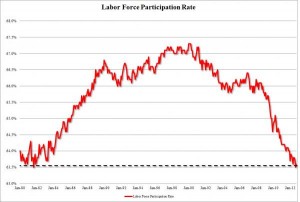When the unemployment rate declines, even by a little bit, it should be good news. But when it declines because people are leaving the workforce in record numbers, it’s not.
The U.S. Bureau of Labor Statistics (BLS) reported that the unemployment rate is now 7.6%, down from 7.7%. But this 0.1% drop is due entirely to a drop in the labor force by 663,000 in March.
Non-farm payroll was expected to increase by 190,000 in March, with the lowest forecast at 100,000. Instead, it increased by a meager 88,000 jobs.
As Zerohedge.com reported, a record 90 million Americans are no longer even looking for work. The labor force participation rate dropped from 63.55% to just 63.3% – its lowest level since 1979.
The BLS reports the U-6 unemployment rate for March at 13.8%, which is a more accurate number than the U-3 rate of 7.6%, as it includes those who have been unemployed long-term.
Those no longer participating, of course, include retiring baby boomers, who are making the transition from funding entitlement programs to using them. The result will be added strains on Medicare, Social Security and Medicaid.
Ignoring Social Security
Social Security is a pay-as-you-go program. In 1950, there were 16 workers supporting each beneficiary of Social Security. The Social Security tax today is 70% higher than it was in the 1950s and there are 3.3 workers supporting payments for each retiree. The Social Security Administration (SSA) projects that the ratio will drop to 2.2 workers pre retiree by 2025 and to 1.8 workers per retiree by 2070.
Yet any attempt to reform the Social Security system has met with resistance from powerful lobbies and members of Congress who are reluctant to make politically unpopular changes to social programs.
More QE
Fewer people looking for jobs will at least reduce the competition for the meager number of new jobs being created. The dismal unemployment numbers also all but guarantee that The Federal Reserve Board’s quantitative easing program will continue.
The Fed’s goal for QE has been to bring the unemployment rate down to 6.5%, which should be a modest goal, given that it was between 4% and 5% for years until the Great Recession began in 2008.
Yet three rounds of easing, plus Operation Twist, have had little impact on the unemployment rate.
You would think that at some point, Chairman Ben Bernanke, President Obama and others would conclude that quantitative easing is not working and that it should be stopped, even if it is artificially inflating stock prices.
Failure to halt quantitative easing will eventually result in higher inflation, and could even lead to hyperinflation. QE will continue, though, because all of that bond buying is giving interest rates low and allowing Congress to continue spending, adding $1 trillion or so to the deficit each year ($900 billion this year, but in four previous years the deficit ranged from $1.3 trillion to $1.4 trillion.)
“Our debt levels have grown so high that the only politically acceptable way to deal with them is to inflate the currency,” according to Jeff Clark of Casey Research. “Politicians and central bankers have no incentive to stop, and thus will continue until disastrous price inflation emerges. Just because it hasn’t occurred yet doesn’t mean it won’t.
Other political solutions simply aren’t realistic. There is no amount of politically acceptable increase in tax revenue or austerity measures that can meet existing and future obligations. Printing money is the only viable solution.”
At Least We’re Not Japan
Meanwhile in Japan, where government spending and bond buying are having an even more dramatically dismal impact, as the country continues financial hara-kiri. As Zerohedge.com reported:
“Just over 4 hours ago we discussed the stunning collapse in 10Y Japanese bond yields. Since then – things have taken a very dramatic turn for the worse for bonds. 10Y JGB yields have exploded higher. The move from 32bps to 65bps triggered circuit breakers on the Tokyo Stock Exchange in JGB Futures trading as JGB prices plunged by their largest amount since September 2002. We can only imagine there is liquidations galore occurring given the massive outsize moves we are seeing in Japanese bonds, stocks, FX, swaps, and CDS. Did the BoJ just lose control?”

